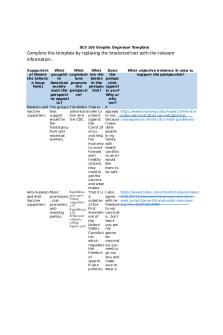Copy of Unit 7 Graphic Organizer Responses to the Great Depression PDF

| Title | Copy of Unit 7 Graphic Organizer Responses to the Great Depression |
|---|---|
| Author | Racheal Bunn |
| Course | African American History(His) |
| Institution | Babson College |
| Pages | 3 |
| File Size | 127.2 KB |
| File Type | |
| Total Downloads | 3 |
| Total Views | 157 |
Summary
History...
Description
Presidential Responses to the Great Depression Graphic Organizers
How did the executive branch respond to the economic crisis known as the Great Depression?
Directions: Below is a set of actions taken by either President Hoover or President Roosevelt in response to the Great Depression. Document the actions of each president in response to the Great Depression by sorting the actions appropriately into the corresponding columns on the graphic organizer. Annotate each action by explaining what it was and the impact that it had on Americans during the Great Depression.
Pleads with big business to hire again Asks private companies to set up charities and donations Reconstruction Finance Corporation State / local government responsibility Federal government direct relief (ex: WPA, CCC) Federal agencies for economic relief (ex: National Recovery Administration Reform American capitalism through federal government programs Smoot-Hawley Tariff New Deal Expansion of Federal Government Presidential Optimism Revenue Act of 1929 (Tax Cut) & Revenue Act of 1932 (Taxes Raised) Calls Congress into session for 100 days Acknowledges tough times
President Hoover
President Roosevelt
Pleads with big business to hire again-was desperate for businesses to open and run Reconstruction Finance Corporation (RFC)- this program began in 1932 which gave government power for loans to give to banks and businesses Smoot-Hawley Tariff- this tariff raised duties in order to protect Americans (businesses and farmers) Revenue Act of 1929 (Tax Cut) & Revenue Act of 1932(Taxes Raised)- this created a tax cut which made recovery more likely and faster belief in small government- Hoover believed that some action by the federal government had to be taken Bonus .State / local government responsibility- the state and local government should find solutions and help people in a rough state
Asks private companies to set up charities and donations- he asked private companies to give money to charity, loan to neighbors, invite troubled neighbors to dinner Federal agencies for economic relief (National Recovery Administration)- used to repair the problems in the economy during the Great Depression (money, unemployment rates) Federal government direct relief (WPA, CCC)money or food given directly from the government to the needy. Reform American capitalism through federal government programs- he tried to save capitalism in his New Deal programs New Deal- establishes the foundation of the modern welfare state while preserving the capitalist system. Presidential Optimism- speeches in which he said this is a temporary problem and encouraged people to be positive thinkers Expansion of Federal Government- he expanded government to give it the power to regulate previously unregulated areas of commerce Calls Congress into session for 100 days-during his first 100 days in office, he presented a series of initiatives to Congress designed to counter the effects of the Great Depression Acknowledges tough times- he noticed the hard times people were having during the 1936 campaigns...
Similar Free PDFs

7-5 Activity Graphic Organizer
- 1 Pages

The Great Depression
- 2 Pages

Graphic Organizer
- 3 Pages

SCS 100 Graphic Organizer
- 1 Pages

Wordsworth Graphic Organizer A
- 2 Pages

Amanda Lang Graphic Organizer
- 4 Pages

Graphic Organizer Table
- 6 Pages
Popular Institutions
- Tinajero National High School - Annex
- Politeknik Caltex Riau
- Yokohama City University
- SGT University
- University of Al-Qadisiyah
- Divine Word College of Vigan
- Techniek College Rotterdam
- Universidade de Santiago
- Universiti Teknologi MARA Cawangan Johor Kampus Pasir Gudang
- Poltekkes Kemenkes Yogyakarta
- Baguio City National High School
- Colegio san marcos
- preparatoria uno
- Centro de Bachillerato Tecnológico Industrial y de Servicios No. 107
- Dalian Maritime University
- Quang Trung Secondary School
- Colegio Tecnológico en Informática
- Corporación Regional de Educación Superior
- Grupo CEDVA
- Dar Al Uloom University
- Centro de Estudios Preuniversitarios de la Universidad Nacional de Ingeniería
- 上智大学
- Aakash International School, Nuna Majara
- San Felipe Neri Catholic School
- Kang Chiao International School - New Taipei City
- Misamis Occidental National High School
- Institución Educativa Escuela Normal Juan Ladrilleros
- Kolehiyo ng Pantukan
- Batanes State College
- Instituto Continental
- Sekolah Menengah Kejuruan Kesehatan Kaltara (Tarakan)
- Colegio de La Inmaculada Concepcion - Cebu








